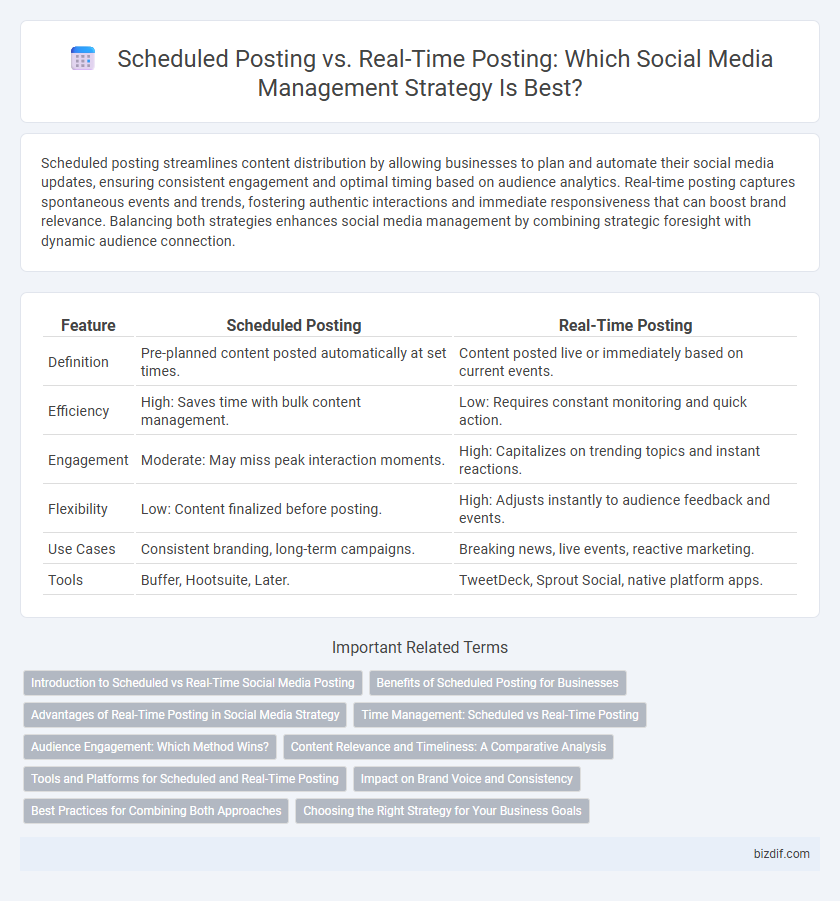Scheduled posting streamlines content distribution by allowing businesses to plan and automate their social media updates, ensuring consistent engagement and optimal timing based on audience analytics. Real-time posting captures spontaneous events and trends, fostering authentic interactions and immediate responsiveness that can boost brand relevance. Balancing both strategies enhances social media management by combining strategic foresight with dynamic audience connection.
Table of Comparison
| Feature | Scheduled Posting | Real-Time Posting |
|---|---|---|
| Definition | Pre-planned content posted automatically at set times. | Content posted live or immediately based on current events. |
| Efficiency | High: Saves time with bulk content management. | Low: Requires constant monitoring and quick action. |
| Engagement | Moderate: May miss peak interaction moments. | High: Capitalizes on trending topics and instant reactions. |
| Flexibility | Low: Content finalized before posting. | High: Adjusts instantly to audience feedback and events. |
| Use Cases | Consistent branding, long-term campaigns. | Breaking news, live events, reactive marketing. |
| Tools | Buffer, Hootsuite, Later. | TweetDeck, Sprout Social, native platform apps. |
Introduction to Scheduled vs Real-Time Social Media Posting
Scheduled social media posting enables consistent content delivery by allowing users to plan and automate posts ahead of time using tools like Hootsuite or Buffer, ensuring optimal audience engagement during peak hours. Real-time posting demands immediate interaction and responsiveness, crucial for timely updates, live events, or trending topics that increase brand relevance and foster authentic connections. Balancing scheduled and real-time strategies maximizes reach, maintaining both strategic timing and agility in dynamic social media environments.
Benefits of Scheduled Posting for Businesses
Scheduled posting enables businesses to maintain a consistent online presence by automatically publishing content at optimal times, maximizing audience engagement across different time zones. It streamlines workflow by allowing marketers to plan and organize content in advance, saving valuable time and resources. Analytics from scheduled posts provide insights into peak engagement periods, helping businesses refine their social media strategies for improved reach and performance.
Advantages of Real-Time Posting in Social Media Strategy
Real-time posting on social media enhances audience engagement by delivering timely, relevant content that aligns with current trends and events. It increases brand authenticity and responsiveness, fostering stronger connections with followers through immediate interaction and feedback. This strategy also improves content visibility as algorithms prioritize fresh and active posts, driving higher organic reach and user interaction rates.
Time Management: Scheduled vs Real-Time Posting
Scheduled posting enhances time management by allowing social media managers to plan and automate content distribution, freeing up resources for strategic tasks. Real-time posting demands immediate attention and flexibility but can boost engagement by responding to trending topics instantly. Balancing scheduled and real-time posting optimizes workflow efficiency while maximizing audience interaction.
Audience Engagement: Which Method Wins?
Scheduled posting ensures consistent content delivery, maintaining audience interest and optimizing engagement during peak activity times identified by analytics. Real-time posting captures spontaneous, trending moments that can increase immediacy and interaction, fostering authentic connections with followers. Brands combining both methods leverage scheduled posts for reliability and real-time updates for responsiveness, maximizing overall audience engagement.
Content Relevance and Timeliness: A Comparative Analysis
Scheduled posting ensures consistent content delivery by targeting optimal engagement times based on audience data, enhancing timeliness and maximizing reach. Real-time posting boosts content relevance by responding instantly to current events or trending topics, fostering immediate interaction and heightened authenticity. Balancing both strategies enables social media managers to maintain ongoing engagement while leveraging timely opportunities for audience connection.
Tools and Platforms for Scheduled and Real-Time Posting
Top tools for scheduled posting include Hootsuite, Buffer, and Later, which enable content planning and automatic publishing across multiple platforms. For real-time posting, platforms like TweetDeck and Sprout Social offer live monitoring and immediate interaction capabilities to engage audiences instantly. Choosing between these tools depends on the need for automated consistency versus dynamic, real-time engagement in social media management.
Impact on Brand Voice and Consistency
Scheduled posting ensures a consistent brand voice by delivering content at optimal times, maintaining audience engagement through regular updates. Real-time posting enhances authenticity and responsiveness, allowing brands to connect dynamically with current events and trending topics. Balancing both strategies amplifies brand consistency while fostering a relatable and timely interaction with followers.
Best Practices for Combining Both Approaches
Combining scheduled posting and real-time posting maximizes audience engagement by balancing consistency with timely relevance. Scheduled posts ensure a steady content flow and optimize peak engagement times, while real-time posts capitalize on trending topics and immediate interactions. Leveraging analytics to monitor performance and audience behavior guides the strategic integration of both methods for effective social media management.
Choosing the Right Strategy for Your Business Goals
Scheduled posting allows businesses to maintain consistent content delivery, optimizing engagement by targeting peak audience activity times identified through analytics. Real-time posting fosters immediate interaction and relevance, ideal for time-sensitive promotions or trending topics that drive spontaneous user engagement. Selecting the appropriate social media strategy depends on analyzing business goals, audience behavior, and content type to maximize reach and impact.
scheduled posting vs real-time posting Infographic

 bizdif.com
bizdif.com